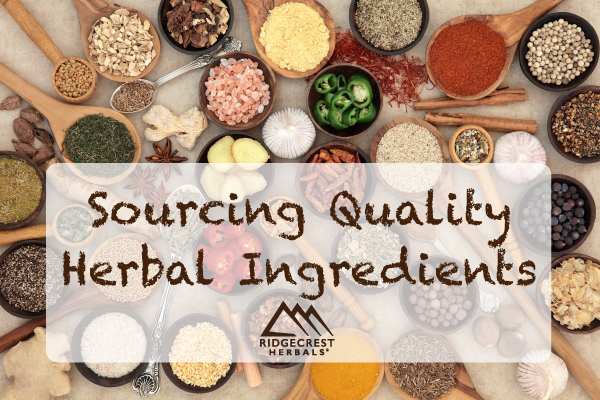Apr 6, 2017
SOURCING QUALITY HERBAL INGREDIENTS
by Matt Warnock, CEO RidgeCrest Herbals

I am often asked where our herbs come from. As an eclectic herbal company, our herbs come from all over the world. Our herbal ingredients come from every continent of the world, except Antarctica-- which doesn't grow many herbs.
Obviously, sourcing quality herbs from so many different geographic locations is a challenge. And we often read sensational headlines about supplements that are laced with prescription drugs, or that contain dangerous chemicals. However, the companies that sell these products are usually fly-by-night firms, that buy complete predefined formulas from disreputable overseas suppliers, and sell them on the Internet. These products are almost always intentionally spiked during production, in order to make the formulas more effective.
Our products, on the other hand, are manufactured entirely in the USA. The ingredients are sourced as individual herbs, and are purchased only from well-known and trusted suppliers. Since the suppliers don't know what the herbs will be used for, there is little incentive to spike them. And since each separate herb has well-known physical and chemical characteristics, it would be difficult to spike them without the adulteration being noticed.
Still, ensuring overall quality of herbal ingredients is a very real challenge, and we meet that challenge with a combination of teamwork and process. Teamwork means that we rely on known and trusted supply partners who make it their business (and reputation) to provide quality ingredients. In addition, we make it our process to further test our products, to ensure that our product specifications are consistently met or exceeded.
There are three important qualities that need to be adequately assured for each individual herbal ingredient: identity, potency, and purity. These major areas of concern can be further broken down as follows.
- Identity: Is this the correct species of herb? Has someone sent common licorice (Glycyrrhiza glabra) instead of Chinese licorice (Glycyrrhiza uralensis)? Is it the right part of the plant? Has someone sent dandelion leaf instead of dandelion root? Has the herb been grown, harvested, and processed correctly? Is it whole herb, cut and sifted pieces, or powder? Are the granules the right size for encapsulation? Is it the correct kind of extract?
- Potency: Is this the correct strength of herb? Is it fresh enough for use? Is it correctly harvested, cleaned, dried, and powdered? If an extract, is it the right process and potency? Does it have the right chemical markers?
- Purity: Has the herb been adulterated with drugs or other chemicals? Has the herb been sulfured to make it look fresher than it is? Are there residues from pesticides or other agricultural chemicals? Does it contain elevated levels of heavy metals like lead and arsenic? Have root crops been washed clean from surrounding soil before drying and powdering? Is the herb contaminated with dangerous germs l ike E. coli or Salmonella? Is the overall bacterial count too high? Or is it too low because it has been improperly radiated or gassed, as opposed to properly treated with steam or UV light to reduce benign bacteria count?
Obviously, not every possible test can or should be performed on every single batch of herbs. As an extreme example, we could run a DNA identity test on every batch, or even every individual drum of powdered herb, but the cost would be astronomical, and would ultimately have to be passed on to the consumer. On the other hand, at least one identity test needs to be run on every ingredient, and microbial tests need to be performed on every batch of finished product.
Some problems are more likely than others, and some problems are more dangerous than others. Likely or dangerous issues should of course be tested for more frequently, and more stringently. Other tests can be omitted, or tested for only periodically, if the problems they detect are unlikely, or not immediately dangerous. If these problems do crop up in random or sporadic quality testing, they can be made part of the routine testing program until they get resolved.
In reality, some tests are just as effective, and far less costly, than others. For example, organoleptic testing (testing by appearance, smell and taste) may be low-tech, but human senses have not yet been surpassed by scientific instruments for speed, effectiveness and value for identity and potency testing in many (but not all) circumstances.
But by far the best way to increase quality and lower costs is to know your supplier. Good companies use well-known and respected suppliers, because they know that their products and their reputations depend on good quality ingredients. Reputable suppliers in turn know their sources of supply, and they do a lot of testing when they buy the herbs, so as to reduce the amount of testing that needs to be done later by their clients.
In the end, quality is largely a matter of trust. Trusted suppliers provide trusted ingredients, which can be used by reputable manufacturers to create trusted and effective products. No amount of testing or government regulation can eliminate all crooked manufacturers from the marketplace, but luckily, you don't have to buy from them. Do your homework, ask your local retailer, and buy effective products from reputable companies, and you can save yourself a lot of trouble.